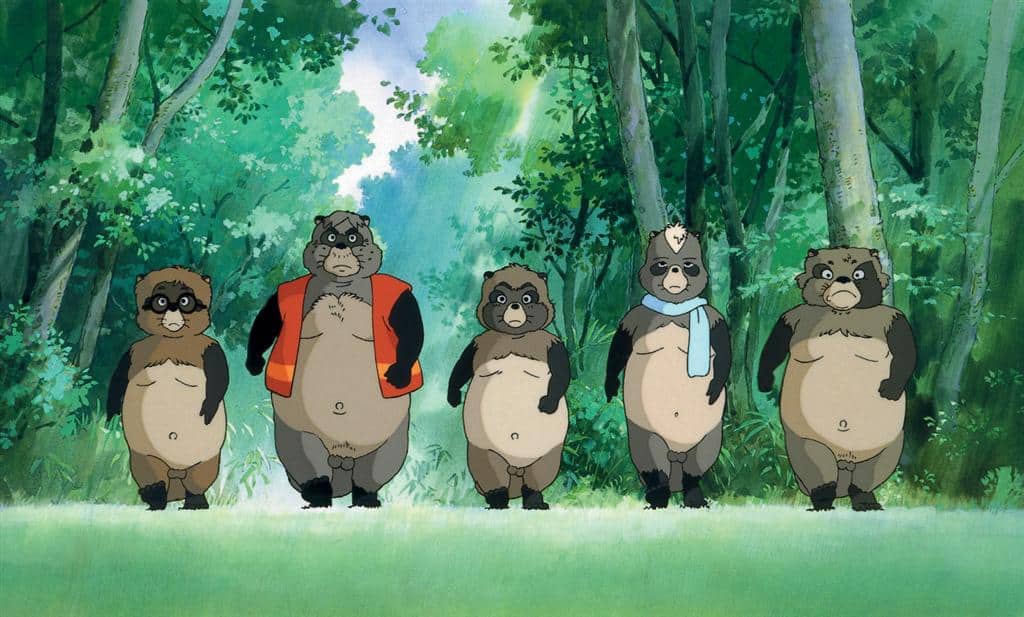An investigative article exploring the similarities between Pom Poko, directed by Isao Takahata, and the gentrification affecting urban communities 30 years after the release of the Studio Ghibli classic.

I had seen Hayao Miyazaki’s The Boy and the Heron at the BFI in December with a few friends, the film is considered to be a farewell to Studio Ghibli and the four decade legacy sustained by him and his team. The Boy and the Heron made me reflect on my relationship with Studio Ghibli films and the safety and comfort of the mythical stories portrayed by the animation studio over the years. I have always been moved by the artistry and heartfelt messages provided by each film and the entire world (or should I say worlds) of Studio Ghibli.
Established in 1985 by long term collaborators and directors Hayao Miyazaki and Isao Takahata and producer Toshio Suzuki. The Japanese animation company is heralded for its masterful, distinctive hand-drawn animation that combines its visual style with deeply relatable, human narratives – exploring themes of grief, conflict and growing pains – appealing to a vast audience of cinephiles, artists, children and adults. The studio has produced some of the most renowned and critically acclaimed animated features in cinema history, such as My Neighbor Totoro, Howl’s Moving Castle and Ponyo – which have received numerous awards and global praise. Lesser known films like Porco Rosso and household classics like Spirited Away are a reminder of how the fantastical Studio Ghibli universe provides viewers with a sense of whimsical, childlike freedom and familiarity. Studio Ghibli has cemented its status as a cultural, cinematic and creative heavyweight which has significantly influenced the film industry and captivated audiences worldwide – Miyazaki, Takahata and Suzuki’s brainchild consistently reminds us that the indomitable human spirit can live through the films we watch, especially animated ones.
One of my favourite Studio Ghibli films has just turned thirty years old and after a recent rewatch I have been pondering on its impact and legacy. Released in 1994, Pom Poko directed by Isao Takahata is a tale rooted in Japanese folklore and is about a tanuki (magical shape-shifting racoon dogs) community who are faced with environmental destruction and displacement. As their land is gradually destroyed to make way for housing developments, the tanuki must find ways to survive and preserve their home. They often use their shape-shifting abilities to thwart the construction of these developments, blending their goofy and inappropriate yet sweet behaviour with powerful commentary on the sobering reality of urban expansion and deforestation.
The film became a box office success and was the number one film in Japan in 1994, it was also selected as the Japanese submission for the Academy Awards that same year. Its profound and poignant exploration of the natural environment resonated with people across the world and highlighted how the disruption of the tanuki’s land not only threatened their community but their history and cultural traditions.
Throughout the film, the Tanuki’s survival efforts become increasingly difficult and with some unable to assimilate and some dying due to their displacement – the tanuki’s plight is a compelling reminder of how humans interact with the natural world and can disrupt the creatures that inhabit it. For me, this is an essential film in the Studio Ghibli canon and a reminder of how people are currently being displaced in their own areas, communities that have existed for centuries and decades in cities across the world.
As an adult who was born and raised in London, I recognise the lively, colourful London I once knew disappearing before my very eyes just like the tanuki who saw their home disappearing before theirs. With a rise in high street galleries that boast abstract art installations, viral artisan bakeries that charge you well over seven quid for an oat latte and empty high end retail hubs – the hustling and bustling metropolis has become a playground for the elite and a shell of itself for many of its working class population.
London has always been known as the epicentre of international trade and although it is a booming financial hub, there is a dark cloud that looms over this city concealing its huge wealth disparities. Predictably, the poorest individuals in society are on the receiving end of this dark cloud. Every area I have lived in has either been unrecognisably regenerated or is currently undergoing gentrification, one area in particular that I discuss a lot is Stratford, east London.
Stratford is an area that was promised so many exciting prospects due to the 2012 Olympics. But the legacy of the Olympics has left a huge socio-economic divide between two postcodes – E15 and E20, the former being one of the poorest areas in Britain and the latter being a trendy hotspot and shopping district. Stratford was assigned the most aggressive social cleansing I have ever seen and the swiftness of East Village’s development fractured my local community – pricing people out of homes they have lived in for decades. One of the most striking aspects of the divided community in Stratford is the co-existence of the two shopping centres: Stratford Shopping Centre and Westfield Stratford City. The former is a place where the homeless set up their cardboard beds for the night before being kicked out by police officers, another is a place where people purchase luxury items and walk through to get to their white-collar professions.
Poverty in gentrified areas is visible to those who experience it or are around it, but for those who do not pay attention it is easy to walk past someone sleeping under a footbridge or for example, ignore the local community in Hackney who were campaigning for their local Iceland to stay open. Austerity has crippled families across the nation and many have to choose between topping up their gas or electric metres or selling their jewellery to pay towards groceries and rent – there are currently more private renters than homeowners in the capital.
Over the 2010s, there has been a shift, as predominantly affluent people from areas outside of London, Manchester and Liverpool are rapidly displacing local working class communities.This influx of (mostly white) middle-class people only raises the property prices to horrendous rates and compromises the livelihoods of locals. Apartments that cost between five hundred thousand and two million pounds are the norm, while the average salary in the UK is thirty-five thousand pounds which most people in areas like Stratford and Homerton are not earning. The general consensus among politicians and developers is that housing is not a right but rather an asset. A recent example of the dangerous nature of gentrification was the widely protested demolition of south London’s Heygate Estate and the beloved Elephant and Castle Shopping Centre which fractured one of the UK’s largest Latinx communities – its replacement is yet another unwanted mixed use development that is due to be completed in 2028. The destruction of local markets and shopping facilities that people rely on for necessities and connection is a callous repercussion of regeneration and a recurring example of cultural erosion.
Gentrification is an elaborate scheme and underscored how inequality is further upheld and distributed by these various, unwarranted construction projects and other structures. Simultaneously, it is about understanding how these communities are heavily policed yet incredibly abandoned by multiple institutions, especially local councils. Regeneration plans are often carefully organised in order to accommodate for the new middle-class that have moved to these areas and alienate residents who have been ignored and neglected over the years.
Areas that have been gentrified or are currently being regenerated are places that have diverse histories, reflecting the struggles of those who have lived there since the Windrush era. Including, Caribbean communities who reside in the Hackney borough and the British Bengali community in Brick Lane. These are minority groups who were attacked relentlessly by the National Front and faced huge tension from police officers. These are communities that have rebuilt this city only to be faced with the prospect of leaving like most people have already done.
This is not an Britain specific issue either, people across the world who live in cities are struggling to survive and the robotic fast paced nature of metropolis’ means that there is no time to rest or contemplate – People in areas such as Tokyo, Manchester, Paris, New York and Toronto are increasingly vocal about the difficulties that come with gentrification and being priced out of their communities.
The demographic change in these cities mean that the affluent people who now reside in these gentrified areas are afforded the privilege of being “protected by police”, while former and current residents of areas like Peckham and Brixton that have been affected by violent crime are vilified. The prioritisation of wealthy people in gentrified areas is a bleak reflection of our current reality. It makes you wonder who protects poor individuals? Who cares about minorities? London is a city filled to the brim with contradictions that the government plays into via regeneration projects including the hatred of the working class while mainly employing them for manual labour, the demolition of social housing that could house the homeless and the creation of hostile architecture.
As the new London further becomes a shell of itself, Peckham and Brixton residents continue to fight for their local grocers to stay open and housing lists increase with more council house tenants declaring themselves homeless. Who will be left? The discussion of moving out of cities, if you are a long term resident is no longer justifiable. The displacement of the working-class is a bubble and one day it will explode.
Referring back to Pom Poko which inspired me to write this piece, I believe that it is more than a magical tale; it is a powerful allegory about the consequences of the displacement of long-standing communities. As someone who has witnessed firsthand the transformation of east London – where local shops and homes are replaced by empty luxury developments —I see striking parallels between the tanuki’s difficulties and our own. What do our lives and our homes look like in the future? With more skyscrapers and private renters than ever when did profits become more important than people, when did shelter turn into an asset? When did our cities become uninhabitable?






